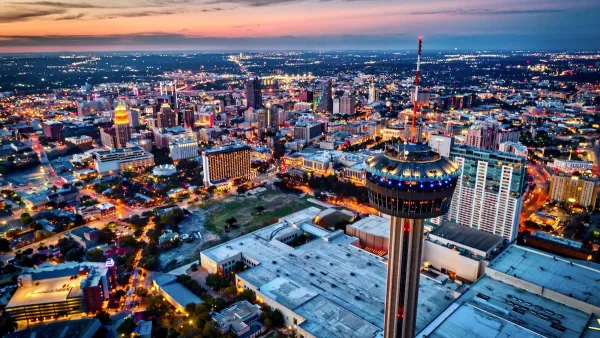In honor of Landscape Architecture Month, Planetizen profiles four students who are studying this influential discipline.
 Name: Konstantinos Alexakis
Name: Konstantinos Alexakis
School / University: University of Pennsylvania / PennDesign
Degree Objective: Master in Landscape Architecture
Expected graduation: May 2007
What compelled you to study landscape architecture?
The context within which Landscape architecture operates as opposed to other design fields. Landscape architecture is more outward looking, it seeks inspiration and responses from a larger scale of regions and ideas.
What is the most recent landscape architecture (or other) book you read that changed the way you think about the profession?
"Between Dystopia and Utopia" by Constantinos A. Doxiadis. It illustrated clearly the particularities and challenges of large scale design. The constant struggle between an ideal situation and the way things happen. The ability to balance these two is the most useful operative tool for landscape architects.
What kind of work do you hope to pursue after graduation?
Any job involving building projects. After two years of representing clearly my ideas in the virtual world of digital or hand made drawings and models, I look forward to try them out in the physical political, financial and socially complex world.
What do you see as the future of landscape architecture?
I believe the opportunities created in China, where whole cities are built or redeveloped, in conjunction with the cultural tradition of experiencing and designing open space in China, will greatly affect the future of landscape architecture by erasing its borders with urban planning and create stronger links with architectural design. More and more landscape architect are called in to come up with development schemes before city planners or architects. This in its turn will affect the way we think of landscape architecture in th rest of the world.
 Name: Natalie Bower
Name: Natalie Bower
School/University: Cornell University
Degree objective: MLA
Expected graduation: December 2007
Previous degrees, major, schools: B.A., Ethnobotany and Sculpture, The Evergreen State College, Olympia, WA 2002. Professional Diploma, Ecological Design & Construction, Yestermorrow Design/Build School, Warren, VT 1999
What compelled you to study landscape architecture?
Prior to pursuing a master’s degree I owned an ecological design firm in northern California, which cemented my transdisciplinarian approach to design. I have chosen to pursue landscape architecture to further my enduring fascination with sustainable design and eco-technologies. I believe my personal commitment to creating positive transformations in the built and natural environments can best be achieved in this dynamic field, and that the burgeoning scope of landscape architecture will encompass a lifetime of passions and interests.
What is the most recent landscape architecture (or other) book you read that changed the way you think about the profession?
Most recently I read Landscape Urbanism Reader, edited by Charles Waldheim, concurrently with Green Infrastructure by Mark Benedict. Both of these texts delineate the necessity for natural systems to serve as the foundation for organizing spatial structures. This approach promotes landscapes, not architecture or transportation systems, as the defining element in the built environment and presents a compelling contrast to the status quo.
What kind of work do you hope to pursue after graduation?
I intend to attain my licensure and work in an interdisciplinary firm that shares my commitment to ecological design and remediation and duly values a high level of aestheticism. Eventually I would like to return to academia to teach while maintaining a professional practice.
What do you see as the future of landscape architecture?
I believe that bio-mimicry will play an increasingly important role in engineered systems, which thus far, have been devised primarily for functionality. Introducing form to this science will likely lead to superior solutions that express the inherent relationship between form and function, thereby improving infrastructure and site design. Further, as links between human and environmental health continue to emerge, the public will likely garner more respect for the profession, as advances in remediation and disaster preparedness and recovery become increasingly necessary and viable.
Advances in these subfields, coupled with increasingly sensitive modeling and monitoring technologies, could support a larger effort to link transformative strategies at multiple scales, thereby improving human and environmental health significantly. Landscape architecture may emerge as the synergistic bridge between not only the allied design professions and the natural sciences, but economic fields as well.
 Name: Mehdi Khalesi
Name: Mehdi Khalesi
School/University: Shahid Beheshti University, School of Architecture and Urban Planning, Landscape Architecture Department
Degree objective: Master Degree in Landscape Architecture and Sustainable Hazard Mitigation in Natural Disaster
Expected graduation: June 2007
Previous degrees, major, schools: Bachelor in Architecture, AIU University
What compelled you to study landscape architecture?
My interest in nature and environmental design Studies, interrelationship between architecture, urban design and environmental design
What is the most recent landscape architecture (or other) book you read that changed the way you think about the profession?
Disaster by Design A Reassessment of Natural Hazard in United States By Deniss Meliti, Joseph Henry Press 1999
What kind of work do you hope to pursue after graduation?
I m so interested in designing functional mixed use public urban open spaces, Formal Landscape Architecture Projects. But I’m going to join Harvard for next fall to pursue a Ph.D. in Urban Design with a landscape architecture approach.
What do you see as the future of landscape architecture?
Human make environment to live and environment make human life, Landscape architecture is Life and Define Life Qualities, Interior Landscape, Environmental Design, Urban Landscape and sustainable landscape Architecture, and I guess landscape architecture can be responsive to endless Question regarding humans life Qualities also improve solutions for global warming by micro Ecology in Urban fabric and it sounds really Promising to play important role in human life.
 Name: Bart Lounsbury
Name: Bart Lounsbury
School/University: Harvard Law School and Harvard Graduate School of Design
Degree objective: JD and Masters in Urban Planning
Expected graduation: June 2007
Previous degrees, major, schools: BA in French Literature (2001), Harvard College
What compelled you to study landscape architecture?
I have always been a rabid tree-hugger and used to wonder how I could become a whaling protestor piloting a little skiff in the North Atlantic. My college major, though, concerned environmental issues only insofar as I bought enough books to chop down an entire forest, but I managed to take a design school course on the ecology of cities during my senior year. I was fascinated by the professor's explanation of various ways (mainly through landscape architecture techniques) to mitigate the environmental impacts of urban and suburban development. This class piqued my interest and motivated me to pursue a joint degree in law and urban planning. In graduate school, I have focused my urban planning curriculum on learning about how cities can be designed and managed to minimize their ecological footprints. As a result, I have taken a number of courses in landscape architecture and have greatly enjoyed being an interloper in the field. If I had the time and money, I would love to stay in school for a landscape architecture degree.
What is the most recent landscape architecture (or other) book you read that changed the way you think about the profession?
Drosscape: Wasting Land in Urban America, by Alan Berger
What kind of work do you hope to pursue after graduation?
I will be a litigation fellow at the Natural Resources Defense Council in Santa Monica, CA, for the next two years. In the long run, I hope that my work (whatever it may be) promotes ecologically sensitive planning, green design, and renewable energy development.
What do you see as the future of landscape architecture?
From my outsider's perspective, I think that landscape architecture will experience increasing integration with other related disciplines. The more I learn about my own fields of study, the more I want to know about others, and I feel that many of the ecological problems we face nowadays unavoidably implicate disciplines from landscape architecture to environmental science to law. Landscape architecture seems to have a unique place in the resolution of these problems because landscape architects often act as the final implementers in a network of many professionals--it is landscape architects who actually design systems to reduce the detrimental impacts of new development and to remediate site contamination, for instance. In order to come up with their solutions, landscape architects have to navigate through restrictions imposed by engineers, ecologists, developers, permitting authorities, etc. I believe that the future of landscape architecture lies in understanding these other disciplines well enough to prevent them from encroaching on landscape architects' work, which would leave the world with projects and designs that are both less functional and less aesthetically provocative.

Planetizen Federal Action Tracker
A weekly monitor of how Trump’s orders and actions are impacting planners and planning in America.

Chicago’s Ghost Rails
Just beneath the surface of the modern city lie the remnants of its expansive early 20th-century streetcar system.

San Antonio and Austin are Fusing Into one Massive Megaregion
The region spanning the two central Texas cities is growing fast, posing challenges for local infrastructure and water supplies.

Since Zion's Shuttles Went Electric “The Smog is Gone”
Visitors to Zion National Park can enjoy the canyon via the nation’s first fully electric park shuttle system.

Trump Distributing DOT Safety Funds at 1/10 Rate of Biden
Funds for Safe Streets and other transportation safety and equity programs are being held up by administrative reviews and conflicts with the Trump administration’s priorities.

German Cities Subsidize Taxis for Women Amid Wave of Violence
Free or low-cost taxi rides can help women navigate cities more safely, but critics say the programs don't address the root causes of violence against women.
Urban Design for Planners 1: Software Tools
This six-course series explores essential urban design concepts using open source software and equips planners with the tools they need to participate fully in the urban design process.
Planning for Universal Design
Learn the tools for implementing Universal Design in planning regulations.
planning NEXT
Appalachian Highlands Housing Partners
Mpact (founded as Rail~Volution)
City of Camden Redevelopment Agency
City of Astoria
City of Portland
City of Laramie


























